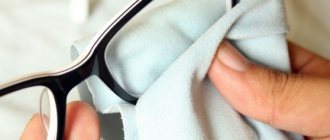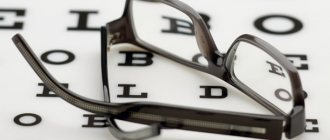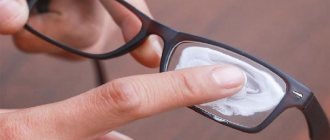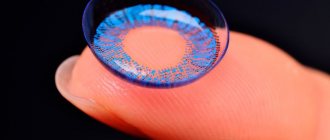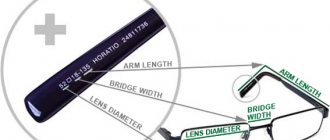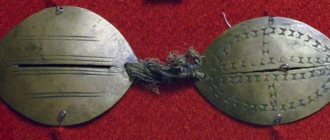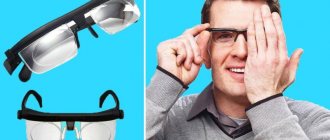Training and starting
All swimming goggles can be divided into two groups:
- training;
- starting for competitions.
Next, we will mainly talk about the choice of training (that is, ordinary) goggles for swimming, since only professionals need starter goggles; they are not needed for ordinary activities.
Let us just note the differences between them:
- The training ones have thicker seal – a rubber gasket between the glasses and the face, thanks to which they fit more comfortably (this part is also called a “seat seal”).
For professional ones, the seal is kept to a minimum, and sometimes there is none at all (“Swedes”, “glasses”) - this is done so that the glasses fit as close as possible to the eyes, thanks to which better streamlining of the head is achieved for participation in competitions.Here are the classic training glasses, with a red seal:
- more glass compared to the starting ones , they have better visibility and, again, more comfortable. The starting lenses have smaller ones, in order, again, to reduce their volume and improve the streamlining of the head.
- Starter glasses have a more stylish design (yes, sometimes this is also important), but this beauty comes at the expense of convenience.
Starting points - The starting ones don’t fly off (or rather, they almost don’t fly off) when jumping from the bedside table.
In general, modern models of training and starting glasses (with the exception of “glasses”) do not differ much from each other - both are quite comfortable, sometimes the difference between them is minimal.
Types of swimming goggles
Accessories of this kind, intended for children, are usually divided into the following types :
- Training. Will be useful for systematic training in the pool. Beginning athletes use similar options. These products are distinguished by molded frames and highly durable lenses. If necessary, you can select options with diopters.
- Starters. Designed for use only during sports competitions. They have excellent hydrodynamics, a much more rigid fit when compared to training ones, and a minimal sealing layer between the face and the lenses.
Based on what to make a choice
In my opinion, the most important thing is that the goggles do not leak while swimming and that water does not get into your eyes.
Everything else in their choice (material, shape, color, design, etc.) is secondary and much less important. This is immediately felt during training - if the glasses leak, then you simply will not be able to exercise normally.
Therefore, the only important criterion when choosing is that the glasses fit tightly to the face and water leakage is excluded. How can this be determined?
The best method is to get glasses from a store, place them on your eyes without the rubber band, and press down until they stick to your face, as shown in this illustration:
If they stick to your face, they will stay on it even without an elastic band. This means that they will not leak.
If the glasses do not stick well and do not stay on your eyes without an elastic band, this means that they will not hold well in water and will let water through.
As a rule, glasses that have good suction:
- a good seal (that rubber band between the lenses and the face);
- the lenses are made of bendable material - polycarbonate, and not of rigid plastic/glass (although rigid ones can also fit well - everything is individual).
The suction cup effect is described very well in this video:
The disadvantage of glasses that stick well to the face is that after exercise they leave marks on the face . Unfortunately, this cannot be avoided - this is the price to pay for preventing water from getting inside.
Don’t be alarmed, these traces pass quickly and without leaving a trace. If for some reason this is unacceptable for you, then you can try swimming with a mask; this option is described in more detail below.
What to do if they leak?
Let's look at the different causes of leaks and how to eliminate them:
- The glasses do not fit tightly to the face . tighten the strap as tightly as possible .
- Skin on the face (in the area where the silicone adheres to them) is greasy - this is actually quite common.
Try degreasing your skin right before class, the easiest way is lather your skin (not your glasses!) with regular soap and rinse with water.Also make sure that no hair gets into the junction area.
- Fault in the glasses themselves.
This is a fairly rare case; usually the problem is a poor fit.However, sometimes there really is a small space between the lens and the rubber band in which it is inserted - pour water and check if the glasses are leaking on their own. Perhaps the lens has shifted - align it, return it to its original position.
- Deformation of the silicone gasket .
Over time, due to chlorine in the water or exposure to the sun or sea water, the elastic band loses its shape. Unfortunately, there is nothing to be done here - you will have to purchase new ones .
Adjusting the bridge of the nose
Most models for adults do not provide the ability to adjust the bridge of the nose, and there is nothing wrong with that . You just need to choose in the manner described above those that fit you well, and then no further adjustment will be required.
However, many children's glasses, as well as some adults, come with an adjustable nose bridge . In this case, when selecting, set the width you or your child needs and check in the same way whether they stay in front of your eyes.
An example of children's glasses with an adjustable nose bridge
Sometimes there is also a replaceable nose bridge , and the kit comes with several options of different sizes.
This is also quite convenient.
How to fix it?
- Frequent breakdown - elastic band breaks.
Options to solve the problem:- Look for used glasses in advertisements or ask around for unnecessary ones at the pool. Perhaps it will be possible to remove the elastic band from them and replace them with yours.
Try using a medical tourniquet instead of an elastic band, but only if you can secure it.
- Broken nose bridge . If you have a replaceable nose bridge, try to find the same one from other glasses (you can also buy used or cheap new glasses with a similar nose bridge and take it from there). If it is not replaceable, then, unfortunately, nothing will help here.
Lens color - which is better?
Once you have chosen one or more models that fit well on your face, the next most important selection criterion is the color of the lenses.
There are two types of lenses for swimming goggles:
- Darkened.
- Undarkened.
Blacked out
It is recommended to purchase them for swimming in the sea and other open waters, or in a brightly lit pool .
These glasses have lenses made of dark or smoky material, an analogy with sunglasses is appropriate here.
Another option for tinted glasses is mirrored ones; they look quite impressive.
Do not buy these glasses if you swim in an indoor pool that is not brightly lit - in such a pool, darkening the lenses will only interfere.
Also, if you decide to purchase tinted glasses, make sure that the lenses are made of a material that contains a UV filter to protect against ultraviolet rays.
Glasses from well-known manufacturers (both darkened and non-tinted) are usually made with such a filter by default, but it is better to double-check this point when purchasing, just in case.
The fact is that a darkened lens deceives the eye - the pupil dilates, and the eye becomes more vulnerable to ultraviolet rays. For this reason, tinted swimming goggles, like regular sunglasses, should be purchased only after checking for UV protection.
Undarkened
This is the best option for swimming in an indoor pool (except for heavily lit ones).
I think the best choice in this case is simply transparent lenses; in them you will see the world around you exactly as it is, without any distortion.
At your discretion, you can also take colored lenses in light shades (the most common are light blue, yellow, pink, green).
How to wash?
- The first rule that is relevant for new glasses: do not touch the lenses with your fingers or anything else - you will damage the antifog applied to them, which protects against fogging.
- After class, wash off chlorine or salt water from your glasses - all you need to do this is rinse under the tap with regular cool running water.
Running water is the best remedy!
Do not use any special detergents on lenses - they may damage them! - If the strap is separated from the lenses (that is, it is removable), then it can be washed separately with soap if necessary. But this only applies to the strap - as stated above, avoid getting detergents on the lenses themselves.
- After rinsing, put the glasses to dry somewhere in a cabinet at home - but not in the open sun, and without wiping the lenses with anything (remember about antifog!).
Price
The rule “the more expensive the better” does not always work when choosing glasses.
A cheap model for 500 rubles, which fits well to the face and therefore does not leak, can beat an expensive model for 2000 rubles, which will not suit you personally and will leak.
Therefore, when purchasing, focus primarily on how the glasses fit, and not on their price.
In this case, of course, you need to take into account that more expensive models will most likely have the following advantages:
- eye protection from ultraviolet radiation (check if it is available);
- protection of lenses from fogging (factory treatment with antifog) should last longer;
- The lens material is less susceptible to scratches.
Fogging
Main article: What to do if your swimming goggles fog up?
Every swimmer sooner or later encounters the fact that his goggles start to fog up.
This is a law of physics : it is cold on one side of the lens (where the cold water of the pool is), warm on the other (where the face is), due to the difference in temperature, condensation begins to form.
Usually, new glasses have a factory protective layer (antifog) applied to them, which protects them from fogging, but over time this layer wears off, so any glasses sooner or later begin to sweat.
There are several ways to combat this:
- Spit (literally) and rub the saliva with your finger.
- Spray your glasses with a special spray - antifog:
- Apply a little shampoo .
Read about the disadvantages and advantages of each of these methods in this article.
Atypical options
Mask
Both at sea and in the pool, instead of glasses, you can swim in a mask with an open nose .
The mask looks like this:
Do not confuse them with closed nose masks , the latter are intended for diving, not sport swimming.
In my opinion, such a mask is not the most recommended option for sports swimming , since it has a much larger volume, which makes the head less streamlined and increases water resistance during swimming. Even if this does not have such a strong effect, we still strive to swim correctly!
This mask is more suitable for swimming at sea; it gives a better overview - you can watch the fish and the seabed. However, you can observe it with regular glasses.
Also, as mentioned above, a mask can be a choice for those who do not like circles around the eyes - marks left by swimming goggles. However, you need to understand that you can’t completely avoid marks here - they will simply be less noticeable and follow a wider contour along which the mask fits to the face.
Swedes
“Swedish glasses” or “glass glasses” are glasses that do not have any rubber seal - only lenses directly adjacent to the face.
They look like this:
The fit of the Swedes on the face is ensured by the fact that they are fully and individually adjustable - the classic set consists of two separate pieces of glass, an elastic band and a removable bridge of the nose (or a cord as an option). You must assemble the glasses yourself - set the length of the elastic band to suit you .
This is primarily a starting model, although there are swimmers who train in them.
From a design point of view, these are perhaps the most stylish glasses out there . However, for comfortable swimming you need to get used to them; not everyone can do this.
These glasses are called “Swedish” because they were originally produced and are still produced by the Swedish company Malmsten.
It is also worth noting that leading manufacturers (Speedo, Arena, AquaSphere, Mad Wave) have starting models with a very small seal, very similar in appearance to “Swedes”.
You can watch how to collect such glasses in this video:
Voting for the best swimming goggles
What glasses would you choose or recommend?
Mad Wave Streamline Optical
19.05 % ( 4 )
Whale
0.00 % ( 0 )
TYR Corrective Optical
4.76 % ( 1 )
Speedo Aquapure Optical
0.00 % ( 0 )
Speedo Mariner Optical
0.00 % ( 0 )
Michael Phelps Xceed Titanium Mirror
9.52 % ( 2 )
Speedo Fastskin 3 Elite Mirror
4.76 % ( 1 )
Arena Cobra Core
0.00 % ( 0 )
Arena Cobra Ultra Mirror
19.05 % ( 4 )
Speedo Speedsocket Mirror
4.76 % ( 1 )
Mad Wave Lane 4 Mirror
4.76 % ( 1 )
TYR Special Ops 2.0 Polarized
0.00 % ( 0 )
Zoggs Phantom
14.29 % ( 3 )
Tyr Black Hawk Racing Femme Polarized
0.00 % ( 0 )
Brands of sports goggles for swimming
Among the leading manufacturers of products for this purpose, one cannot fail to note the following:
Aqua Sphere (Italy) - gained fame thanks to the release of innovative accessories with curved lenses, which can significantly increase the viewing angle in the aquatic environment.
- Arena is a young, but already quite well-known brand, created by Adidas and known for its rich model range, including products of various modifications: transformers, glasses with diopters and other options.
- Finis (USA) - the use of modern technologies allows this company to produce highly functional products that have an aesthetic appearance.
- Speedo (Australia) - this brand uses the latest technology in the production of swimming goggles with UV protection and anti-fog accessories.
- ZOGGS (Australia) is the brand that was the first to market UV-protective swimming goggles with a double strap.
A young swimmer must be provided with a suitable pair of swimming goggles. This useful accessory will greatly facilitate the learning process and allow you to get the most out of it.
Fitting
To purchase swimming goggles, go to specialized sports stores. But you can’t buy anything without trying it on.
- Take the product you like and press it to your eyes. Once the lenses stick to your skin, remove your hands from the glasses. Make a few head movements. If after all this they remain in place, then this option will be ideal, since thanks to the tight fit, water will not get inside.
- The strap of the product should fit the circumference of your head. When wearing a swimming accessory, you should feel comfortable and natural.
- Also pay attention that the product does not cut into the bridge of your nose.


